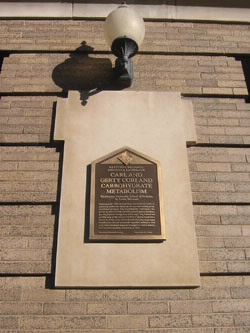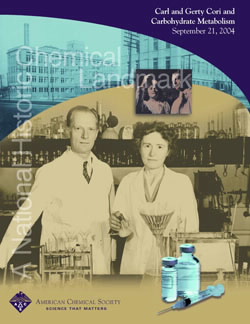Carl and Gerty Cori and Carbohydrate Metabolism
Dedicated September 21, 2004, at the Washington University School of Medicine in St. Louis, Missouri
In brilliant collaboration, Carl and Gerty Cori studied how the body metabolizes glucose and advanced the understanding of how the body produces and stores energy. Their findings were particularly useful in the development of treatments for diabetes. In 1947 the Coris shared a Nobel Prize for their discoveries.
Contents
Carl and Gerty Cori: The Early Years
Carl Cori and Gerty Radnitz shared much in common. Both were born in 1896; both came from families that were Austrian in origin but had lived in Prague for generations. And when they met in their first year of medical school they found other things they had in common: a love of research and an enthusiasm for mountain climbing.
Yet their backgrounds were very dissimilar. Carl came from a Catholic family which had a history of university professors on both sides. As he wrote in his autobiographical article "The Call of Science," "It would have been unusual for me to go in a different direction. Rejection of the values of one's parents was not as prevalent then as it is today, and family tradition was still a strong influence." When Carl was two years old, his family moved to Trieste, then part of the Austro-Hungarian Empire, where his father was named director of the Marine Biological Station. Carl's father had studied medicine, but later earned a Ph.D. in zoology.
Cori later wrote that "Trieste was a fascinating city in which to grow up. The early contact in school with different language groups developed in me an immunity against racial propaganda." Carl was educated at the classical gymnasium, whose syllabus still included rigorous training in Latin and Greek. Equally important in his education was experience at his father's research institute. Carl often accompanied his father on field trips on a motor boat to collect marine samples. The elder Cori captained the boat and lectured on geology, botany and the history of the region, with side trips to visit Roman ruins. Summers were spent in the Tyrolean Alps with his extended family where the young Carl Cori developed a lifelong love of mountaineering.
Less is known about the background of Gerty Radnitz. She was Jewish. Her father was a chemist who devised a method for refining sugar and became a successful manager of sugar refineries. Her mother, a cultured woman, was a friend of Franz Kafka, the influential novelist. The oldest of three sisters, Gerty was educated at home until ten, when she was sent to a private school.
Carl Cori and Gerty Radnitz first met in 1914 — at the beginning of World War I — when they entered Carl Ferdinand University in Prague to study medicine. Carl described Gerty as "a young woman who had charm, vitality, intelligence, a sense of humor, and love of the outdoors — qualities which immediately attracted me. A very pleasant period followed during which we would plan and study together, or go off on excursions to the countryside, or on a skiing expedition." The medical students studied inorganic and organic chemistry, physics and biology in the first year, adding biochemistry, physiology and pharmacology in the second year.
This seemingly idyllic student environment ended abruptly when Carl was drafted into the Austrian army in 1916, during the first World War. Like for so many young men who served in that conflict, the war had a profound affect on Carl's view of human behavior. In addition, his experiences in the war and its immediate aftermath left him gloomy about the ability of doctors to control disease. In 1918 Carl was assigned to a barracks that served as a hospital for infectious diseases near the front lines on the Piave River in Italy. Disease was rampant, and "the influenza epidemic with its high mortality rate among the poorly nourished soldiers and civilians and the inability to be of any help came as a great shock to me."
After the war, Carl and Gerty were reunited. In 1920 they received their medical degrees and published their first joint research paper. That same year the young couple was married in Vienna, where they were pursuing postdoctoral studies. Carl split his time between the Internal Medicine Clinic and the Pharmacology Institute, both at the University of Vienna. He was able to conduct research, a rarity due to the economic deprivation of post-War Europe, because his father sent him a shipment of frogs. He used the animals to study the mechanism of the seasonal variation of the vagus action of the heart. Gerty Cori worked in pediatrics at the Karolinen Kinderspital (children's hospital), where she conducted research on temperature regulation before and following thyroid treatment and published several papers on blood disorders.
Carl Cori wrote many years later that "life in Vienna had its compensations," but in fact it also had its deprivations, and Gerty developed symptoms of xerophtalmia, a condition caused by vitamin A deficiency and which was cured only when she returned to Prague, where she ate a better diet. Because of the difficulty of life in Europe and because Gerty was Jewish and a woman, which made finding an academic position difficult, the Coris decided to investigate immigrating to the United States. In 1921 Carl interviewed for a position at the State Institute for the Study of Malignant Disease (now Roswell Park Memorial Institute) in Buffalo, New York. But when he heard nothing further, he accepted a position instead with Otto Loewi in the Pharmacology Department at the University of Graz. Gerty remained in Vienna at the Children's Hospital.
Carl Cori found working with Loewi, who discovered that acetylcholine was the substance that led to vagus stimulation of the heart, intellectually rewarding. It was also a period in his life when he planned for the future. It was while he was at Graz that Cori decided to study intestinal absorption and the metabolism of sugar in animals. Family tradition holds that Gerty's interest in sugar metabolism stemmed from her father, who when be became diabetic, said to his daughter, who was a doctor, "Find me a cure."
But despite the joy of working with Loewi, Carl found the atmosphere at Graz disturbing. The living conditions were poor, and it had been necessary for him to prove his Aryan descent to obtain employment at the university. So determined were the Coris to leave Europe that they applied to the Dutch government to serve as doctors in Java. But the offer eventually came from Buffalo, and the Coris eagerly accepted.
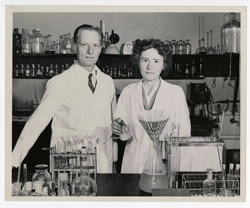
My grandfather, that is, my mother's father, toward the end of his life became diabetic and he said to his daughter, who was a doctor, 'Find me a cure.'"
— Tom Cori, Living St. Louis, a production of KETC in St. Louis, Missouri.
Carl and Gerty Cori: A Truly Collaborative Relationship
Carl Cori accepted a position as a biochemist at the State Institute for the Study of Malignant Disease in Buffalo, N.Y., in 1922. Gerty Cori joined him six months later, after taking a position as an assistant pathologist. The two were never apart again professionally.
At the beginning of their tenure at the Institute, the Coris encountered opposition to their working together. Gerty Cori was told she would lose her job if she strayed from her laboratory in the pathology department. Soon, however, their colleagues came to understand and respect the Coris wish to work together, which they did until Gerty's death in 1957.
In 1931 Carl Cori was offered the chairmanship of the pharmacology department at Washington University School of Medicine in St. Louis. The offer came as something of a surprise, since his only previous academic experience was as a one-year adjunct assistant professor at the University of Buffalo. As chairman, Cori had to run the department, equip a research laboratory, and teach medical students. Gerty Cori received a research position in the same department, with only a token salary. Years later, when she was ill, Gerty told Mildred Cohn: "I don't feel guilty about accepting my full salary [now] in spite of my frequent absence, because when Carl and I first came here, they paid me 10 percent of that they paid him."
In his autobiography, Carl Cori related one other incident when the Coris encountered opposition to their working collaboratively. He was offered a position at a good university, with three stipulations: That he take speech lessons, that he cease working on insulin, and that he stop collaborating with his wife. He declined because the last two stipulations were unacceptable. On one visit to the university, Gerty was told that it was "un-American" for a husband and wife to work together. Eventually most opposition to their working together melted away, but Gerty Cori did run up against other forms of gender discrimination. When the Coris were hired at Washington University, she received one-tenth Carl's salary, even though they were equal partners in the laboratory.
Theirs was a truly collaborative relationship.Their son Tom says his mother had the ideas; then they both would go into the laboratory to execute the idea or disprove it. Their closeness extended beyond their scientific endeavors; as Mildred Cohn, who knew the Coris and has written about them, relates, they complemented each other intellectually: "She would start a sentence, he would finish it."
Carl Cori summed up the nature of their partnership in his remarks at the Nobel banquet in 1947: "Our collaboration began 30 years ago when we were still medical students at the University of Prague and has continued ever since. Our efforts have been largely complementary, and one with the other would not have gone as far as in combination."
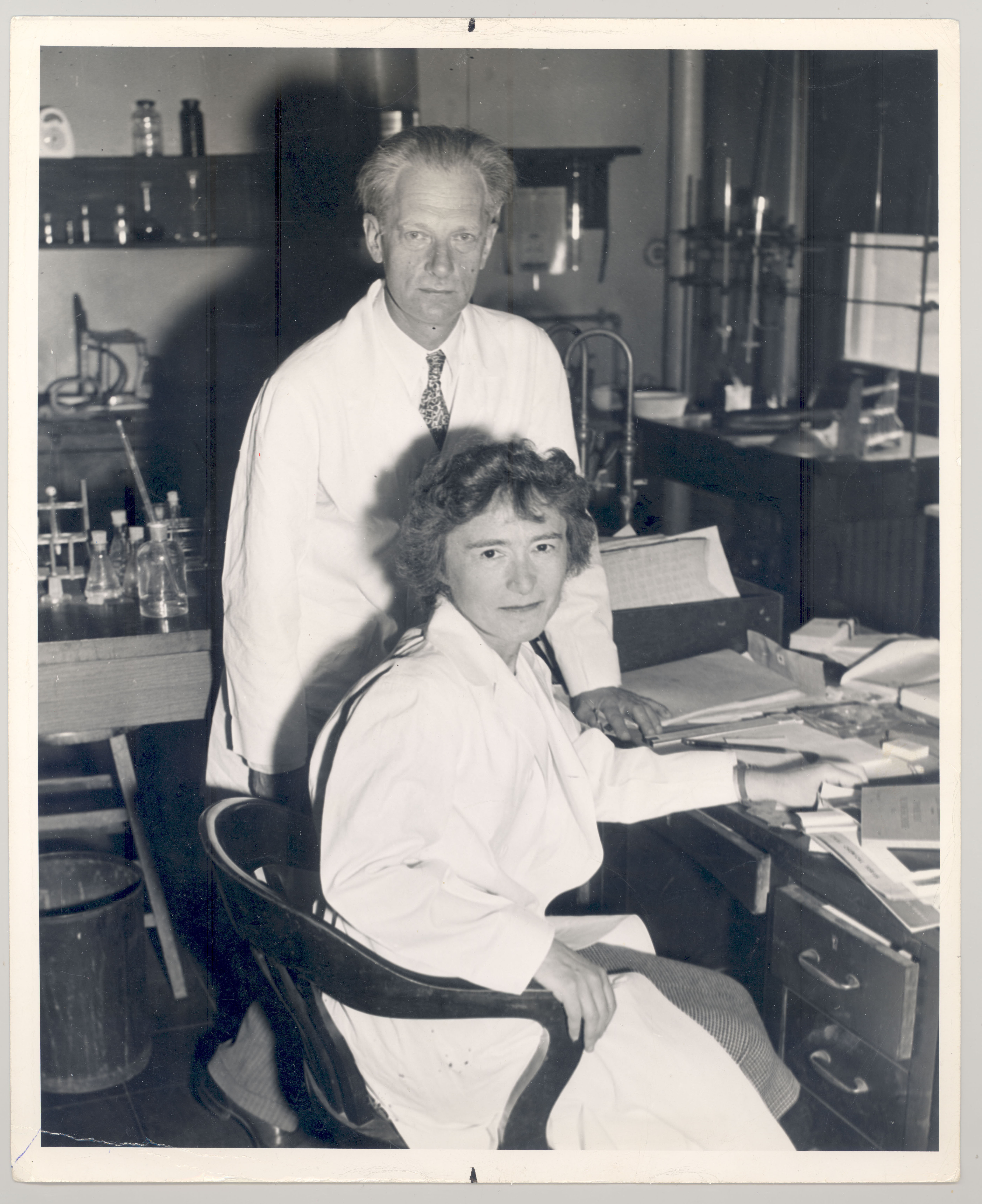
They were a remarkable pair. Gerty would have flights of fancy. She'd come up with extraordinary ideas. Cori had the ability to put them into concrete questions to answer. And therefore as a team they were extraordinary."
— David Kipnis, postdoctoral fellow in the Coris' laboratory at Washington University
The 1947 Nobel Prize in Medicine or Physiology: Discovery of the "Cori Cycle," "Cori Ester"and Glycogen Synthesis
Carl and Gerty Cori spent more than three decades exploring how the human body metabolizes glucose. It was known in the 1920s that faulty sugar metabolism could lead to diabetes, and it was also known that insulin kept the disease in check. The effect of insulin on blood sugar levels had been observed, but scientists did not understand the biochemical mechanism behind insulin’s
effect or how carbohydrates were metabolized.
An early breakthrough in their research came with the discovery of the "Cori cycle." This discovery stemmed from their research into the question of what regulates blood glucose concentration and how the human body metabolizes sugar.
Sugar metabolism supplies energy for life's activities. The human body is unable to make the slightest muscular movement without the burning of sugar. In the 19th century, the great French physiologist, Claude Bernard, discovered glycogen, the starch-like substance found in muscles and the liver. Glycogen molecules contain glucose, and when needed the glycogen is processed by the body into glucose. This mechanism keeps the glucose level in the blood constant even though the supply is uneven.
The interplay between glucose and glycogen is at the heart of what is known as the "Cori cycle." The Coris found that insulin increased the oxidation of glucose and its conversion to glycogen in muscle, as well as in the liver. Epinephrine, or adrenaline, worked in reverse, decreasing muscle glycogen and liver glycogen. Since other researchers had established that muscle glycogen does not contribute significantly to blood glucose, the Coris concluded that muscle glycogen must form an intermediate substance which then circulates through the blood to the liver. The Coris theorized — and eventually demonstrated — that this intermediate was lactic acid and was integral to the "cycle of carbohydrates," or the "Cori cycle," which they depicted in 1929:
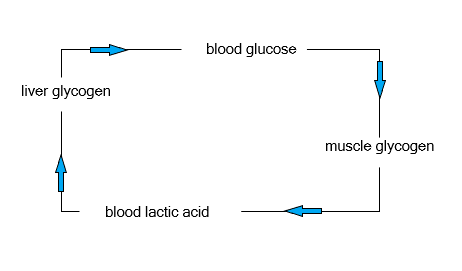
In 1931 Carl Cori wrote a review article in Physiological Reviews, which summarized what was then known about mammalian carbohydrate metabolism. He observed that most research to date had been done on whole animals and very little on tissue preparations. Studying whole animals had led to advances in understanding regulatory processes but had yielded little knowledge regarding underlying metabolic mechanisms. In his autobiography, Carl Cori notes it was "this realization that led us to examine the potentialities of tissue preparation" which he called "a most exciting period in biochemistry." The 1931 article appeared on the eve of the Coris move to Washington University: it gave an indication of the direction of their future research on the mechanism of glycogen metabolism, more properly known as glycogenolysis.
Experimenting on minced skeletal muscle from frogs, the Coris determined a new intermediate of glycogen breakdown, which they described as glucose-1-phosphate and which came to be known as the "Cori ester." Working with Sidney Colowick, their joint graduate student, the Coris established the compound's structure and discovered the enzyme that catalyzed its formation, which they named phosphorylase. In addition, the Coris demonstrated that the reversal of the phosphorylase-catalyzed reaction produced glycogen, the first time a biological macromolecule had been synthesized in a test tube. The Coris, in a collaboration with Arda Green that produced four seminal papers in 1942-1943, crystallized the enzyme glycogen phosphorylase from muscle and investigated its chemical properties.
The Coris path-breaking research into the enzyme-catalyzed chemical reactions of carbohydrate metabolism resulted in their sharing the Nobel Prize in Physiology or Medicine in 1947 with Bernardo Houssay of Argentina. The Nobel committee cited the Coris "for their discovery of the course of the catalytic conversion of glycogen" and Houssay "for the discovery of the importance of the anterior pituitary hormone for the metabolism of sugar." Their son Tom, who was then eleven, remembers his parents "were in high spirits" when they received news of the Nobel award, but they also told a newspaper reporter that they were "pleased, overwhelmed, and too busy to celebrate."
The Coris' Later Years
The years in St. Louis were productive and rewarding for the Coris. In 1946, Carl switched departments, becoming chairman of biological chemistry. They were able to collaborate on research, the only obstacles being the demands placed on Carl Cori because of his administrative duties as department chairman. They did seminal work in the mechanism of glycogen utilization. And they liked St. Louis, so much so that they turned down prestigious offers from Harvard, Berkeley and the Rockefeller Institute. The Coris were supportive of the many scientists who flocked to their laboratory in St. Louis to study and work with them, including seven future Nobel Laureates. All were invited to take part in the daily brown-bag lunches in the library, where the conversation included current research interests but also might touch on a raft of non-scientific subjects.
Most visitors were impressed by the depth of their interests and knowledge. They had many friends in St. Louis, a modern house and a garden in which they divided the labor; she grew the flowers, he raised the vegetables. The Coris read widely. Gerty was interested in history, biography and modern novels, while her husband was knowledgeable in archaeology, poetry and art. Carl was also a poet and fluent in German, French, Italian and English.
The excitement and reward of receiving the Noble Prize in 1947 was overshadowed by the knowledge that Gerty Cori had developed an incurable and fatal illness, myelosclerosis, which leads to anemia. The Coris discovered Gerty's illness while mountain climbing in the Rockies in the summer of 1947. She suffered for ten years. Carl later wrote that "she bore [the disease] with great fortitude and without letup in her scientific interests." She continued her research almost until the end, working on the enzymatic lesions in different forms of glycogen storage disease and describing with Joseph Larner a new enzyme they called "the debrancher." Mildred Cohn writes that near the end of her life, Gerty Cori said: "I gave a party to squelch the rumor that I was dead." She died at home in 1957.
In 1960 Carl Cori married Anne Fitzgerald-Jones. The two shared many common interests, including archaeology, art and literature. In 1966 he retired from Washington University and was appointed visiting professor of Biological Chemistry at Harvard Medical School. At the same time he maintained a laboratory at Massachusetts General Hospital, continuing his research until he became too ill in the 1980s.
Cori's research went in a new direction in these years as he became interested in the relationship between mutations of an enzyme, glucose-6-phospatase, to metabolic diseases. In this work he began collaborating with a noted geneticist Salomé Glüecksohn-Waelsch of the Albert Einstein College of Medicine in New York. Cori and GlÜecksohn-Waelsch published their first joint paper in 1968 and the last in 1983, when Carl became too ill to continue research. Carl Cori died in 1984.
Further Reading
- Gerty T. Cori (1896-1957) (Washington University School of Medicine)
- Carl F. Cori (1896-1984) (Washington University School of Medicine)
- Carl Ferdinand Cori and Gerty Theresa Cori (Chemical Heritage Foundation)
- Carl Ferdinand Cori Biography (NobelPrize.org)
- Gerty Theresa Cori, née Radnitz Biography (NobelPrize.org)
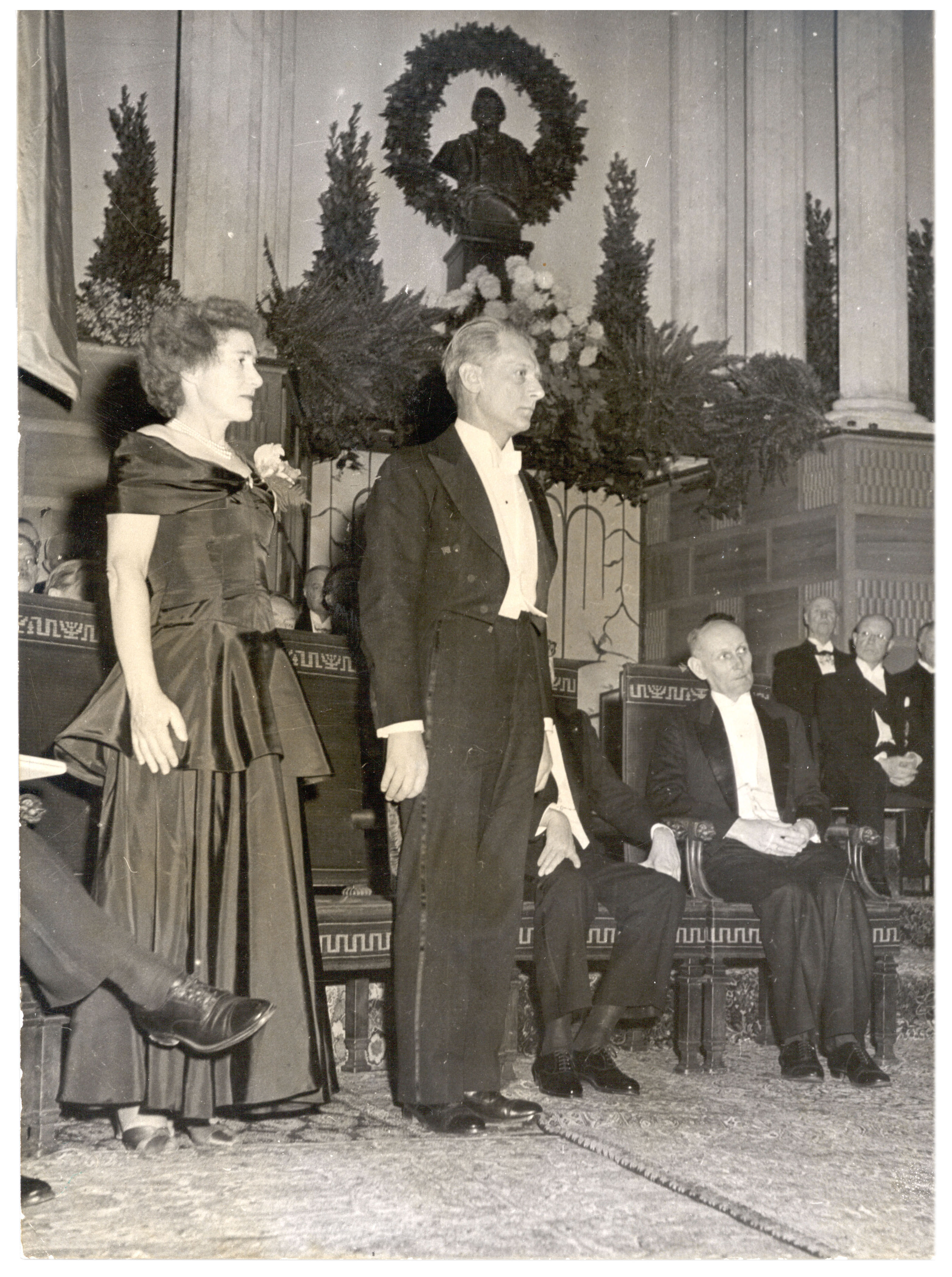
Landmark Designation and Acknowledgments
Landmark Designation
The American Chemical Society dedicated the research of Carl and Gerty Cori on the metabolism of carbohydrates at The Washington University School of Medicine a National Historic Chemical Landmark on September 21, 2004. The plaque commemorating the event reads:
Beginning in the 1920s, Carl and Gerty Cori conducted a series of pioneering studies that led to our current understanding of the metabolism of sugars. They elucidated the "Cori cycle," the process by which the body reversibly converts glucose and glycogen, the polymeric storage form of this sugar. They isolated and purified many of the enzymes involved in glucose metabolism. The work of the Coris advanced understanding of glycogen breakdown in cells and of metabolic regulation. Building on their work, others developed improved techniques to control diabetes. The Coris were awarded a Nobel Prize in 1947.
Acknowledgments
Adapted for the internet from “Carl and Gerty Cori and Carbohydrate Metabolism,” produced by the National Historic Chemical Landmarks program of the American Chemical Society in 2004.
